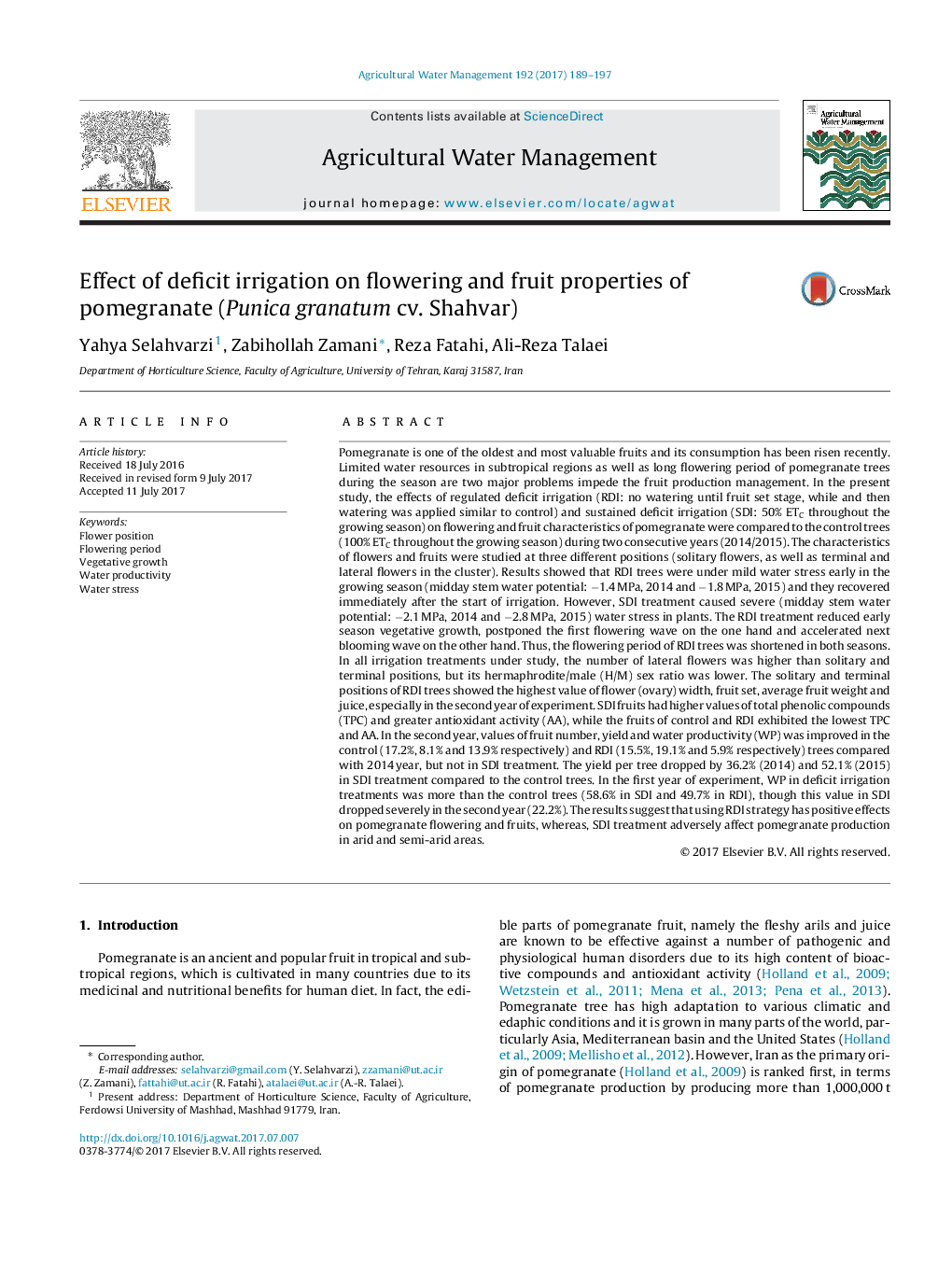| کد مقاله | کد نشریه | سال انتشار | مقاله انگلیسی | نسخه تمام متن |
|---|---|---|---|---|
| 5758429 | 1622888 | 2017 | 9 صفحه PDF | دانلود رایگان |
عنوان انگلیسی مقاله ISI
Effect of deficit irrigation on flowering and fruit properties of pomegranate (Punica granatum cv. Shahvar)
دانلود مقاله + سفارش ترجمه
دانلود مقاله ISI انگلیسی
رایگان برای ایرانیان
کلمات کلیدی
موضوعات مرتبط
علوم زیستی و بیوفناوری
علوم کشاورزی و بیولوژیک
علوم زراعت و اصلاح نباتات
پیش نمایش صفحه اول مقاله

چکیده انگلیسی
Pomegranate is one of the oldest and most valuable fruits and its consumption has been risen recently. Limited water resources in subtropical regions as well as long flowering period of pomegranate trees during the season are two major problems impede the fruit production management. In the present study, the effects of regulated deficit irrigation (RDI: no watering until fruit set stage, while and then watering was applied similar to control) and sustained deficit irrigation (SDI: 50% ETC throughout the growing season) on flowering and fruit characteristics of pomegranate were compared to the control trees (100% ETC throughout the growing season) during two consecutive years (2014/2015). The characteristics of flowers and fruits were studied at three different positions (solitary flowers, as well as terminal and lateral flowers in the cluster). Results showed that RDI trees were under mild water stress early in the growing season (midday stem water potential: â1.4Â MPa, 2014 and â1.8Â MPa, 2015) and they recovered immediately after the start of irrigation. However, SDI treatment caused severe (midday stem water potential: â2.1Â MPa, 2014 and â2.8Â MPa, 2015) water stress in plants. The RDI treatment reduced early season vegetative growth, postponed the first flowering wave on the one hand and accelerated next blooming wave on the other hand. Thus, the flowering period of RDI trees was shortened in both seasons. In all irrigation treatments under study, the number of lateral flowers was higher than solitary and terminal positions, but its hermaphrodite/male (H/M) sex ratio was lower. The solitary and terminal positions of RDI trees showed the highest value of flower (ovary) width, fruit set, average fruit weight and juice, especially in the second year of experiment. SDI fruits had higher values of total phenolic compounds (TPC) and greater antioxidant activity (AA), while the fruits of control and RDI exhibited the lowest TPC and AA. In the second year, values of fruit number, yield and water productivity (WP) was improved in the control (17.2%, 8.1% and 13.9% respectively) and RDI (15.5%, 19.1% and 5.9% respectively) trees compared with 2014Â year, but not in SDI treatment. The yield per tree dropped by 36.2% (2014) and 52.1% (2015) in SDI treatment compared to the control trees. In the first year of experiment, WP in deficit irrigation treatments was more than the control trees (58.6% in SDI and 49.7% in RDI), though this value in SDI dropped severely in the second year (22.2%). The results suggest that using RDI strategy has positive effects on pomegranate flowering and fruits, whereas, SDI treatment adversely affect pomegranate production in arid and semi-arid areas.
ناشر
Database: Elsevier - ScienceDirect (ساینس دایرکت)
Journal: Agricultural Water Management - Volume 192, October 2017, Pages 189-197
Journal: Agricultural Water Management - Volume 192, October 2017, Pages 189-197
نویسندگان
Yahya Selahvarzi, Zabihollah Zamani, Reza Fatahi, Ali-Reza Talaei,